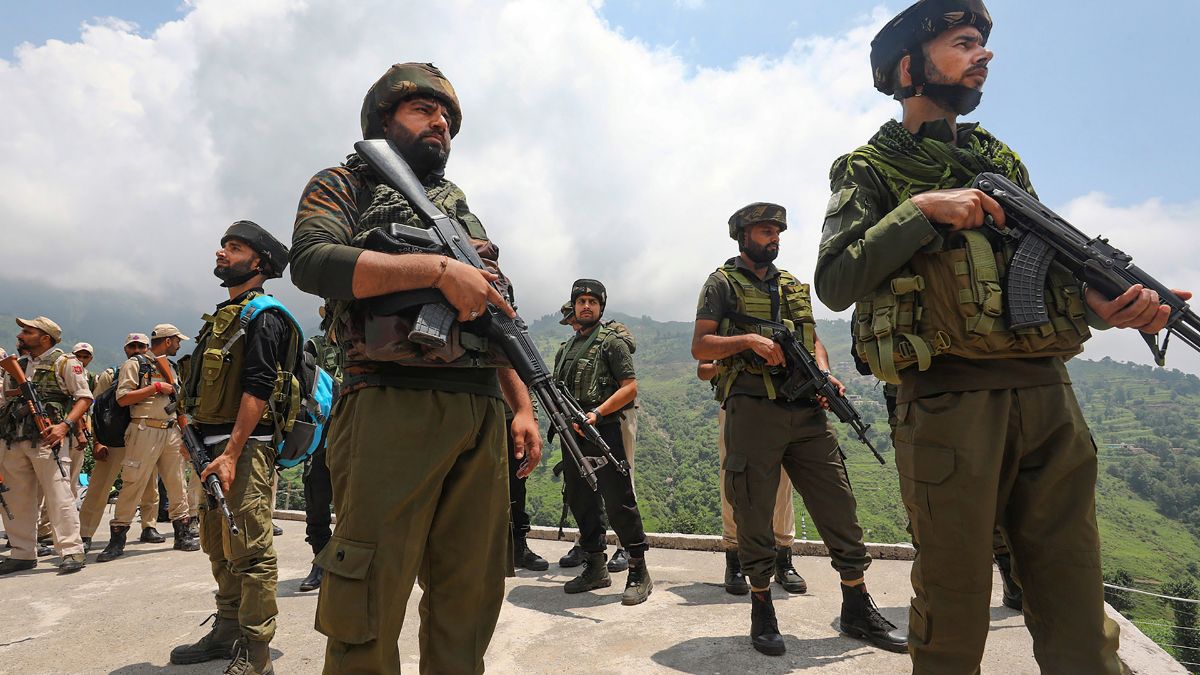The rising terror attacks in Jammu have raised alarm. Several such incidents have been reported in the past couple of months. On Wednesday (July 10) evening, terrorists opened fire at a police post in Udhampur’s Basantgarh. However, the cops promptly retaliated, with terrorists fleeing the spot.
This comes just two days after five Indian Army personnel were killed as terrorists ambushed a convoy in the Kathua district in Jammu.
Why are terror strikes increasing in the Jammu region? Let’s take a closer look.
Recent terror attacks in J&K
The terror incident in Kathua has led security personnel to launch a massive combing operation in the area in the dense forests. As per PTI, about 50 people have been detained for questioning concerning the deadly ambush.
On Tuesday, an encounter broke out between security forces and terrorists in the higher reaches of Jammu’s Doda district as special forces were tasked with searching for the perpetrators of the Kathua attack.
Recent twin attacks in South Kashmir’s Kulgam resulted in the death of six terrorists and the martyrdom of two soldiers.
June also saw a spate of terror incidents in Jammu. On June 26, three terrorists died in a gunfight with security forces in the Gandoh region of Doda district.
Impact Shorts
More ShortsOn the day of the swearing-in of Prime Minister Narendra Modi, terrorists fired upon a bus carrying Hindu pilgrims in the Reasi district of Jammu division, leading to the death of at least nine people and injuring over 30.
As per media reports, The Resistance Front (TRF), an offshoot of Pakistan-based terrorist group Lashkar-e-Taiba (LeT), took responsibility for the attack.
At the time, J&K witnessed three terror attacks in three days.
A gunfight erupted after terrorists attacked a joint checkpoint of police and security forces in Doda, injuring five Army soldiers and one cop. In another incident, a Central Reserve Police Force (CRPF) personnel was killed in an exchange of fire with terrorists hiding in Saida Sukhal village in Kathua district.
In the wake of the surge in violence, top Army officials reviewed security in the UT this week to ensure operational preparedness and increased vigilance in the region, reported PTI.
Jammu saw 43 terror attacks in 2023, while at least 20 such incidents have been reported this year.
The rise in the attacks on security forces and civilians in the last few months in the Jammu region reflects a shift in the trend of terrorism from Kashmir to the region bordering the forests of the Pir Panjal range.
Why is this happening?
Unlike the Kashmir Valley, Jammu was relatively peaceful over the past 20 years until 2021.
As per an India Today report, Pakistan-based terror organisations have been taking advantage of Jammu’s vast and complex terrain to send armed militants across the International Border (IB) and the Line of Control (LoC). Terrorists disguise as civilians and collect weapons from hideouts with the help of local guides.
“From foreign terrorists crossing the LoC and leading the attacks, there has been a trend now to push local militants to the forefront to give the insurgency a more home-grown face as international pressure has mounted on Pakistan. New terror groups have also come up claiming to be behind some of the attacks. These aspects present new challenges,” according to The Hindu opinion piece.
The rising terror incidents in J&K could be an attempt by militants to deter authorities from holding Assembly polls in the Union Territory later this year.
The terror groups based in Pakistan have changed their strategy since the abrogation of Article 370, shifting focus from Kashmir Valley, which has a heavy presence of security forces, to Jammu, the India Today report added.
“The message that terrorists and their handlers seem to be sending is that Jammu and Kashmir is not yet ready for Assembly elections. The overarching agenda of the government must be the revival of the political process, come what may,” Shashank Ranjan, a retired infantry officer of the Indian Army with experience in J&K, wrote for Indian Express.
Speaking to HT, Lieutenant General BS Jaswal (retired) said that the number of troops in areas south of the Pir Panjal range had dropped as forces were being deployed in Eastern Ladakh in the aftermath of the 2020 standoff with China along the Line of Actual Control (LAC).
“The terrorists want to exploit the void created by the redeployment of forces. Also, the Jammu region is reporting more terror incidents because infiltrators are looking at using ingress routes into the Kashmir valley from this side,” he said to the newspaper.
Fresh infiltration by terrorists has complicated matters. A top source told India Today TV heavy infiltration started ahead of the monsoon season.
“Pakistan has crossed the red line of infiltration. These are not home-grown operatives, so these men have come with deliberate knowledge of the Pak army. From the pattern, it seems newer infiltration has taken place from Samba-Heeranagar and Rajouri-Poonch, and it does seem the tunnels are active and the terrorists infiltrating seem to be split into smaller groups. I worry they will not stop here. The targets are getting bigger. They have been involved in Jammu in a big way. But the security grid will have a response on this,” former DGP Jammu and Kashmir Police, Dilbagh Singh, was quoted as saying by India Today.
Terrorist groups are using modern technology to find new routes and flame the insurgency.
The gap in intelligence gathering in Jammu is also evident.
“Pakistan is not able to do much in Kashmir, so terrorists are crossing the border and LoC. The same level of intelligence (both tech and humanity) does not exist in the Jammu region. The terrorists will go for softer targets where there is minimum investment (effort) and maximum output. It means they are hitting temporary outposts and vehicle outposts and even civilians,” Lt Gen (Retd) KJS Dhillon explained to India Today.
With inputs from agencies


)

)
)
)
)
)
)
)
)



